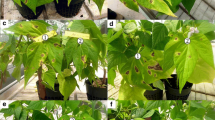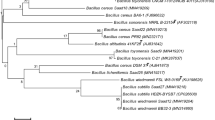Abstract
Common bean root microbiome was used to research for potential biocontrol agents of phytopathogenic fungi as Fusarium sp., Macrophomina sp., and Alternaria sp. causal agents of root rot disease on host plants. Therefore, a bacterial collection of 90 endophytic and rhizospheric isolates was established from field-grown common bean plants in Tunisia and screened for their antifungal activity against pathogenic fungal strains. Antifungal activity was checked at biochemical and genetic levels. Twelve bacterial strains exhibited up to 71% of inhibition of the three pathogenic strains of Fusarium sp., Macrophomina sp., and Alternaria sp. Biocontrol assays conducted under controlled conditions demonstrated that Bacillus amyloliquefaciens, Bacillus halotolerans, Bacillus velezensis, Agrobacterium fabrum, and Pseudomonas lini displayed the highest protective effect on common bean cv. Coco blanc. These bacterial strains were associated with significant plant growth promotion up to 217%, in comparison with control plants. Biochemical analysis of the antagonistic and plant growth promoting activity revealed the production of xylanases, chitinases, siderophore, hydrogen cyanide, phosphate-solubilizing activity, and the production of indole-3-acetic acid, particularly in Bacillus spp. strains. Polymerase chain reaction revealed the presence of lipopeptide biosynthetic genes encoding surfactin, iturin, bacillomycin, and fengycin. The study unveiled that common bean root microbiome contains potential bacterial strains that exhibit efficient biocontrol activity of Fusarium sp., Macrophomina sp., and Alternaria sp., and act as plant growth promoters. Considering various plant growth promoting and biocontrol traits, the study showed the superiority of the Bacillus spp. strains among different common bean root microbiomes.





Similar content being viewed by others
References
Bahroun A, Jousset A, Mhamdi R, Mrabet M, Mhadhbi H (2018) Anti-fungal activity of bacterial endophytes associated with legumes against Fusarium solani: assessment of fungi soil suppressiveness and plant protection induction. App Soil Ecol 124:131–140
Bano N, Musarrat J (2003) Characterization of a new Pseudomonas aeruginosa strain NJ-15 as a potential biocontrol agent. Curr Microbiol 46:324–328
Beneduzi A, Ambrosini A, Passaglia LMP (2012) Plant growth-promoting rhizobacteria (PGPR): their potential as antagonists and biocontrol agents. Genet Mol Biol 35:1044–1051
Broughton WJ, Hernandez G, Blair MW, Beebe SE, Gepts P, Vanderleyden J (2003) Beans (Phaseolus spp.) model food legumes. Plant Soil 252:55–128
Celmeli T, Sari H, Canci H, Sari D, Adak A, Eker T, Toker C (2018) The nutritional content of Common bean (Phaseolus vulgaris L.) Landraces in comparison to modern varieties. Agronomy 166:1–9
Durairaj K, Velmurugan P, Park JH, Chang WS, Park YJ, Senthilkumar P, Oh BT (2018) An investigation of biocontrol activity Pseudomonas and Bacillus strains against Panax ginseng root rot fungal phytopathogens. Biol Control 125:138–146
El Arbi A, Rochex A, Chataigné G, Béchet M, Lecouturier D, Arnauld S, Jacques P (2016) The Tunisian oasis ecosystem is a source of antagonistic Bacillus spp. producing diverse antifungal lipopeptides. Res Microbiol 167:46–57
Feigl F, Anger V (1966) Replacement of benzidine by copper ethylacetoacetate and tetra base as spot-test reagent for hydrogen cyanide and cyanogen. Analyst 91:282–284
Fuentes JCDO, Castillo FDH, Francisco NF, Morales GG, Ochoa YM (2018) In vitro antagonism of Bacillus strains against Fusarium species. Mycopath 14:1–2
Gond SK, Bergen MS, Torres MS, White JF Jr (2015) Endophytic Bacillus spp. produce antifungal lipopeptides and induce host defence gene expression in maize. Microbiol Res 172:79–87
Kelemu S, Fory P, Zuleta C, Ricaurte J, Rao I, Lascano C (2011) Detecting bacterial endophytes in tropical grasses of the Brachiara genus and determining their role in improving plant growth. Afr J Biotechnol 10:965–976
Keshavarz-Tohid V, Taheri P, Muller D, Prigent-Combaret C, Vacheron J, Taghavi SM, Moënne-Loccoz Y (2017) Phylogenetic diversity and antagonistic traits of root and rhizosphere pseudomonads of bean from Iran for controlling Rhizoctonia solani. Res Microbiol 168:760–772
Khan N, Martinez-Hidalgo P, Ice TA, Maymon M, Humm EA, Nejat N, Sanders ER, Kaplan D, Hirsch AM (2018) Antifungal activity of Bacillus species against Fusarium and analysis of the potential mechanisms used in biocontrol. Front Microbiol 9(2363):1–12
Marcenaro D, Valkonen JPT (2016) Seedborne pathogenic fungi in common bean (Phaseolus vulgaris cv. INTA Roja) in Nicaragua. PLoS ONE. https://doi.org/10.1371/journal.pone.0168662:1-18
Martins SA, Schurt DA, Seabra SS, Martins SJ, Ramalho MAP, De Souza Moreira FM, da Silva JCP, da Silva JAG, de Medeiros FHV (2018) Common bean (Phaseolus vulgaris L.) growth promotion and biocontrol by rhizobacteria under Rhizoctonia solani suppressive and conducive soils. Appl Soil Ecol 127:129–135
Meziadi C, Richard MMS, Derquennes A, Thareau V, Blanchet S, Gratias A, Pflieger S, Geffroy V (2016) Development of molecular markers linked to disease resistance genes in common bean based on whole genome sequence. Plant Sci 242:351–357
Miller JH (1972) Experiments in molecular genetics. Cold Spring Harbor Laboratory, Cold Spring Harbor
Mohite B (2013) Isolation and characterization of indole acetic acid (IAA) producing bacteria from rhizospheric soil and its effect on plant growth. J Soil Sci Plant Nutr 13:638–649
Mrabet M, Mhamdi R, Tajini F, Tiwari R, Trabelsi M, Aouani ME (2005) Competitiveness and symbiotic effectiveness of a R. gallicum strain isolated from root nodules of Phaseolus vulgaris. Eur J Agron 22:209–216
Mrabet M, Elkahoui S, Tarhouni B, Djebali N (2015) Potato seed dressing with Pseudomonas aeruginosa strain RZ9 enhances yield and reduces black scurf. Phytopathol Mediterr 54:265–274
Murphy J, Riley JP (1962) A modifed single solution method for the determination of phosphate in natural waters. Anal Chim Acta 27:31–36
Negi YK, Prabha D, Garg SK, Kumar J (2017) Biological control of ragi blast disease by chitinase producing fluorescent Pseudomonas isolates. Organ Agric 7:63–71
Nicolopoulou-Stamati P, Maipas S, Kotampasi C, Stamatis P, Hens L (2016) Chemical pesticides and human health: the urgent need for a new concept in agriculture. Front Public Health 4:1–8
Paparu P, Acur A, Kato F, Acam C, Nakibuule J, Musoke S, Mukankusi C (2018) Prevalence and incidence of four common bean root rots in uganda. Exp Agric 54:888
Saber WI, Ghoneem KM, Al-Askar AA, Rashad YM, Ali AA, Rashad EM (2015) Chitinase production by Bacillus subtilis ATCC 11774 and its effect on biocontrol of Rhizoctonia diseases of potato. Acta Biol Hung 66:436–448
Scandiani MM, Ruberti DS, Giorda LM, Pioli RN, Luque AG, Bottai H, Ivancovich JJ, Aoki T, O’Donnell K (2011) Comparison of inoculation methods for characterizing relative aggressiveness of two soybean sudden-death syndrome pathogens, Fusarium virguliforme and F. tucumaniae. Trop Plant Pathol 36(3):133–140
Schwyn B, Neilands JB (1987) Universal chemical assay for the detection and determination of siderophores. Anal Biochem 160:47–56
Sendi Y, Ben Romdhane S, Mhamdi R, Mrabet M (2019) Diversity and geographic distribution of fungal strains infecting field-grown common bean (Phaseolus vulgaris L.) in Tunisia. Eur J Plant Pathol 153:947–955
Singh SP, Schwartz HF (2010) Breeding common bean for resistance to diseases: a review. Crop Sci 50:2199–2223
Srinivasa N, Rymbai H, Rajesh AM, Ganeshamoorthi P, Ramanujam B, Yathish KR (2015) Morphological and biochemical characterization of antagonist Pseudomonas isolates. Int J Agric Sci 9:14–23
Torres MJ, Brandan CP, Sabaté DC, Petroselli G, Erra-Balsells R, Audisio MC (2017) Biological activity of the lipopeptide-producing Bacillus amyloliquefaciens PGPBacCA1 on common bean Phaseolus vulgaris L. pathogens. Biol Control 105:93–99
Van Lenteren JC, Bolckmans K, Köhl J, Ravensberg WJ, Urbaneja A (2018) Biological control using invertebrates and microorganisms: plenty of new opportunities. Biocontrol 63:39–59
Vural C, Soylu S (2012) Prevalence and incidence of fungal disease agents affecting bean (Phaseolus vulgaris L.) plants. Res Crops 13(2):634–640
Vurukonda SSKP, Giovanardi D, Stefani E (2018) Plant growth promoting and biocontrol activity of Streptomyces spp. as endophytes. Int J Mol Sci 194(4):952. https://doi.org/10.3390/ijms19040952
Weisburg WG, Barns SM, Pelletier DA, Lane DJ (1991) 16S ribosomal DNA amplification for phylogenetic study. J Bacteriol 173:697–703
Acknowledgements
The authors are grateful for the Laboratory of Legumes from Tunisia and Julius Kühn-Institut (JKI), Institute for Biological Control (Heinrichstr. 243, 64287 Darmstadt, Germany) technical staffs for assistance. This study was funded by the Tunisian Ministry of Higher Education and Scientific Research and the bilateral project Tunisia-Germany “Microtuge” (TUNGER 2016-2018).
Author information
Authors and Affiliations
Corresponding author
Ethics declarations
Conflicts of interest
The authors declare that they have no potential conflict of interest.
Additional information
Publisher's Note
Springer Nature remains neutral with regard to jurisdictional claims in published maps and institutional affiliations.
Rights and permissions
About this article
Cite this article
Sendi, Y., Pfeiffer, T., Koch, E. et al. Potential of common bean (Phaseolus vulgaris L.) root microbiome in the biocontrol of root rot disease and traits of performance. J Plant Dis Prot 127, 453–462 (2020). https://doi.org/10.1007/s41348-020-00338-6
Received:
Accepted:
Published:
Issue Date:
DOI: https://doi.org/10.1007/s41348-020-00338-6




